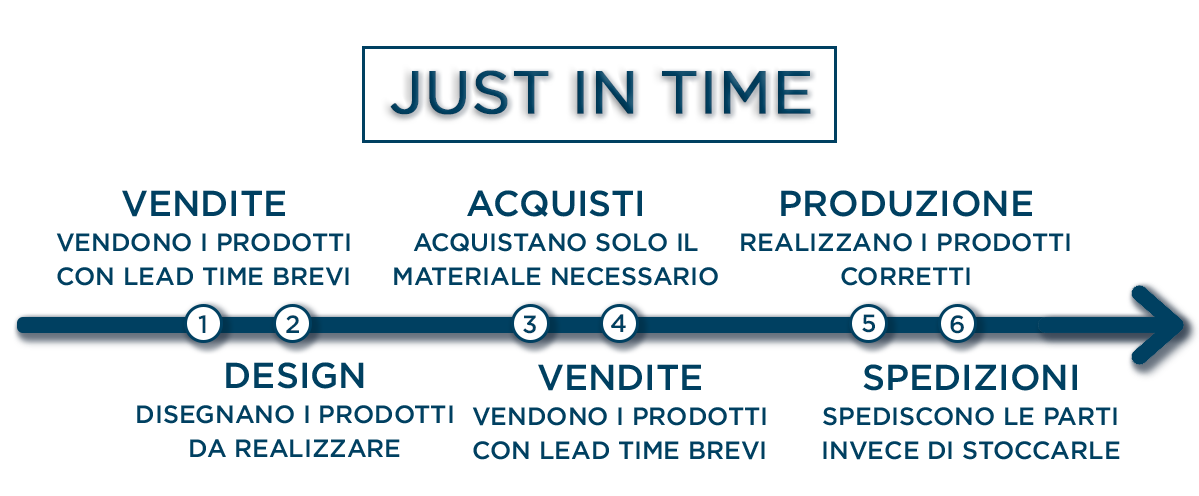Just In Time (or JIT) has evolved from Toyota’s well-known Manufacturing System. Just In Time simply means producing (or rather assembling) the products necessary to meet the demand in the shortest possible lead time.
JIT – Background and History
JIT is a Japanese management philosophy that has been applied in practice since the early 1970s in many Japanese manufacturing organizations. It was initially developed and perfected within Toyota production plants by Taiichi Ohno as a means to meet consumer demands while minimizing delays. Taiichi Ohno is often referred to as the father of JIT philosophy.
Advantages and benefits of Just In Time
JIT production has the ability, if properly adapted to the organization, to strengthen the organization’s competitiveness on the market by substantially reducing waste and improving product quality and production efficiency.
Whatis Just In Time in production
Just-in-time is a management philosophy and not a technique; it originally referred to the production of goods to exactly meet customer demand, in terms of time, quality and quantity, whether the “customer” was the final purchaser of the product or another element of the production line.
The Just In Time today
Today, however, it means producing while minimizing the waste generated, where “waste” means its most general meaning and therefore also includes time, resources and materials.
As an example, when Dell receives an order for a specific computer, instead of picking it up from the shelf, Dell will have previously stored the components and assembled them to form the computer, as soon as it receives the order. Hopefully this process will take very little time and the order will be shipped Just In Time.

When to use the Just In Time method
This technique works well when a limited number of items can be stored on a consumption forecast to produce a large combination of finished products once the order is received. The same philosophy can be found in Late Differentiation or DDMRP (Demand Driven Mrp). These are all fashions that are based on the same principle: store the components at a level where the usage forecast is quite good and assemble when an order arrives from a customer.
Just In Time and continuous improvement
Address core issues – anything that does not add value to the product.
Design systems to identify problems.
Strive for simplicity: Simpler systems can be easier to understand, easier to manage, and less likely to fail
A product-oriented layout: reduces the time it takes to move materials and parts.
Quality control at source: each worker is responsible for the quality of their production.
Poka-yoke: “Infallible” tools, methods, masks, etc., prevent errors
Preventive maintenance, total production maintenance: ensuring that machinery and equipment work perfectly when needed and continuously improving them.
Eliminate waste.
There are seven types of waste and scrap in Just In Time type productions:
- Waste from overproduction.
- The loss of time due to waiting products.
- Waste due to logistics.
- Processing waste.
- The waste of inventory.
- The waste of movement.
- Waste for defective products.
Cleaning and organization of the workplace
Keeping the workstation tidy and clean leads to several benefits, such as reduced set-up times: it increases flexibility and allows smaller batches. The ideal batch size is 1 single element. Multi-process management: A multi-skilled workforce has increased productivity, flexibility, and job satisfaction. Leveled/mixed production – smooths the flow of products through the factory.
Kanban: Simple tools to “drag” products and components through the process.
Jidoka (Autonomation): provides machines with the autonomous ability to use judgment, so workers can do more useful things than just watching them work.
Andon (fault lights) – to signal problems to initiate corrective action.
Make your supply chain more advanced.
Make the best decision every day based on easy-to-create, easy-to-read scenarios built from secure data and processes. Anticipate competition by reacting to market changes in the best possible way.
Equip your company with a powerful tool that can be used remotely, giving visibility into what is happening to the production chain, from suppliers to delivery to the customer.
Contact our experts for more information.

